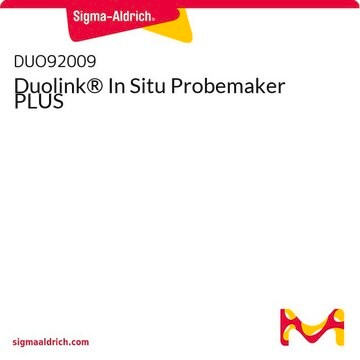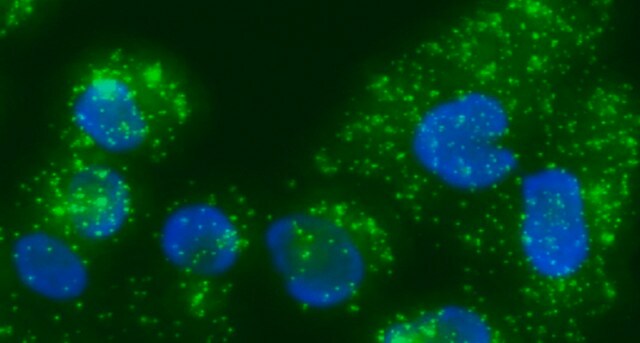Unfortunately, the kit components are not sold separately.
DUO94004
Duolink® flowPLA Detection Kit - FarRed
Duolink® PLA kit for Flow Cytometry with FarRed Detection
Synonym(s):
in situ Proximity Ligation Assay, Flowcytometry-PLA, Protein Protein Interaction Kit
Select a Size
About This Item
Recommended Products
product line
Duolink®
technique(s)
flow cytometry: suitable
immunofluorescence: suitable
proximity ligation assay: suitable
fluorescence
λex 644 nm; λem 669 nm
suitability
suitable for fluorescence
shipped in
dry ice
storage temp.
−20°C
General description
Specificity
Use appropriate laser for λex 644 nm excitation
Use appropriate filter for λem 669 nm emission
Application
Duolink® flowPLA Detection Kits will enable sensitive detection of proteins, protein-protein interactions, and protein modifications within cell populations by flow cytometry. To perform a Duolink® flowPLA experiment, you will need fixed, suspended cells, two primary antibodies that specifically recognize your proteins of interest, a pair of PLA probes (one 100RXN PLUS and one 100RXN MINUS), wash buffer, and a Duolink® flowPLA Detection Kit. The flowPLA Kits are available with 5 different fluorophores: Violet, Red, Green, Orange, or FarRed. The flowPLA Kits contain all the necessary reagents to perform the amplification and detection of bound PLA probes by flow cytometry. Analysis is carried out using standard flow cytometry assay equipment. User must provide a fixed cell suspension, primary antibodies, and corresponding PLA Probes.
Follow the Duolink® PLA Flow Cytometry Protocol to use this product.
Visit our Duolink® PLA Flow Cytometry page on how to run a Duolink® flow experiment, applications, troubleshooting, and more.
Application Note
Primary antibodies are needed. Test your primary antibodies (IgG-class, mono- or polyclonal) in a standard immunofluorescence (IF), immunohistochemistry (IHC), or immunocytochemistry (ICC) assay to determine the optimal fixation, blocking, and titer conditions. Flow validated antibodies are recommended.
Let us do the work for you, learn more about our Custom Service Program to accelerate your Duolink® projects
View full Duolink® product list
- to detect interaction and complex formation between cellular retinoic acid binding protein 1 (Crabp1) and the components of rapidly accelerated fibrosarcoma (Raf) kinase- MAPK-Erk kinase (Mek) signaling pathway[1]
- to study protein interaction in human cultured MOLT-4 cells and HeLa cells[2]
- to visualize Beclin-1 protein interaction with 14-3-3t in neurons[3]
- to study protein interactions in graft endothelial cells[4]
Features and Benefits
- Analyze protein protein interactions with flow cytometry readout
- Analyze cell populations with Proximity Ligation Assay
- Increased sensitivity due to rolling circle amplification for low abundant targets
- No overexpression or genetic manipulation required
- Relative quantification possible
- Works with any flow cytometer instrumentation
- Easy to follow flexible protocol
- Publication-ready results
Components
- 5x Detection Solution - FarRed (DUO84004)
- 5x Ligation Buffer (DUO82009)
- 5x Amplification Buffer (DUO82050)
- Ligase (1U/μL)
- Polymerase (10U/μL)
See datasheet for more information.
Legal Information
signalword
Danger
hcodes
pcodes
Hazard Classifications
Resp. Sens. 1
Storage Class
10 - Combustible liquids
Choose from one of the most recent versions:
Already Own This Product?
Find documentation for the products that you have recently purchased in the Document Library.
Customers Also Viewed
Articles
Considerations for proper experimental design, preparation and execution of the Duolink® PLA for flow cytometry protocol.
General tips and tricks for proper experiment execution, aid in identifying potential problems, and provide solutions to ensure a successful Duolink® PLA experiment for flow cytometry.
Duolink® PLA kit enhances flow cytometry for detecting protein interactions accurately.
Learn how Proximity Ligation Assay technology works and how the protein-protein interaction control kit can confirm in situ detection of EGF-induced EGFR-HER2 dimerization.
-
Is it possible to just buy the 5x Detection Solution separately?
1 answer-
Helpful?
-
-
Can I use this kit in conjunction with staining for other markers? If so, would you recommend staining with the PLA kit first, followed by staining with other primary-conjugated antibodies?
1 answer-
It is possible to counterstain after the Duolink in situ amplification. It is recommended to apply the counterstaining protocol after the completion of the Amplification step in section 7.3, step 5 of the Duolink In Situ Fluorescence User Manual.
Please see the protocol below:
https://www.sigmaaldrich.com/technical-documents/protocol/protein-biology/protein-and-nucleic-acid-interactions/duolink-counterstainHelpful?
-
-
Hello, can I also dilute the 5 x detection stock in something else than high purity water? Maybe PBS?
1 answer-
It is not recommended to use any other solvent to dilute the 5x detection stock due to the sensitivity of this reaction. The Duolink kits have been optimized for use under the conditions described. Deviation from the protocol may not offer the best results. Please see the link below to view the full product information for the Duolink PLAFlow kits:
https://www.sigmaaldrich.com/technical-documents/technical-article/protein-biology/protein-and-nucleic-acid-interactions/duolink-pla-flow-cytometry-kitsHelpful?
-
Active Filters
Our team of scientists has experience in all areas of research including Life Science, Material Science, Chemical Synthesis, Chromatography, Analytical and many others.
Contact Technical Service










